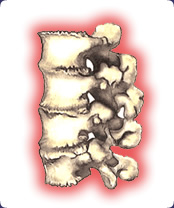Normal

Vertebrae are smooth and healthy with no subluxations present.
This allows equal spacing of the discs and proper curvature of the spine.
The openings allow the nerves to flow without interference.
Phase I

Subluxations and spinal degeneration usually begin with a vertebra out of alignment.
When a vertebra is subluxated it can’t move properly and causes undue stress to the surrounding discs and nerves. Some subluxations are minor and may not show up until years later.
Phase II

Untreated subluxations can cause calcium deposits and bone spurs.
The surfaces of the subluxated vertebrae become rough and uneven and can cause the compressed discs to lose fluid and lose their cushion. The nerves also become irritated and problems can become chronic.
Phase III

The degenerative process accelerates and causes a loss of bone mass.
The discs start to collapse, the fusion process begins and health problems may become more severe.
Phase IV

This is the final stage of degeneration. Bones are fused together becoming permanently subluxated and joints are immobilized.
Nerve damage and soft tissue damage are part of the degeneration process.
